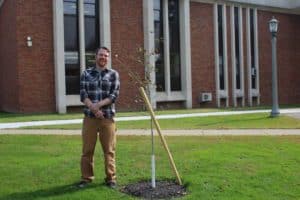WEST LIBERTY, W.Va., Oct. 18, 2022 — West Liberty University gained some green friends recently, as four Eastern Redbuds and two Green Hawthorn trees were planted on the quad, near Arnett Hall, and at the entrance to campus.

“These young trees can live about 80 – 100 years and are currently 6 – 9 feet tall. They should bloom next spring,” explained Dr. James Wood, professor of Biology and Ecology.
Both of these trees are flowering examples with the Green Hawthorn providing white flowers that turn to small berries, and the Eastern Redbuds providing a showy pink bloom. The Hawthorns feature a thorn which will inhibit deer as well.
Funding came from the Northern Panhandle Resource Conservation and Development Council, a partnership between local, state and federal agencies, focusing on land and water conservation and management, along with community development.
Also coming soon and funded by the same grant will be two informational kiosks that will be placed near WLU’s Pollinator Garden and near Campbell Hall of Health Science.
The trees were planted by the WLU grounds crew.
The hilltop campus also benefited from the addition of educational signage telling the story of the American Chestnut Trees, which were planted on the campus in 2016.
Signage was installed near the sidewalk that connects the lower parking lot behind Blatnik Hall with the main campus.
The chestnut tree disappeared from the region due to blight and the significance of its reappearance is important to tell. The chestnut trees and signs will educate people on the cultural and ecological history of the American Chestnut Tree. Prized for the edible nuts and high-quality timber, Appalachian settlers depended on the trees, according to the West Virginia chapter of the Chestnut Foundation, which donated the trees.
At the beginning of the 20th century, the fungal pathogen responsible for chestnut blight was accidentally imported into the U.S. from Asia. It was first detected in New York in 1904, spreading rapidly throughout the eastern forests and by 1950, the fungus had eliminated the American chestnut as a mature forest tree.
Dr. Wood is a faculty member in the College of Sciences. Biology majors include Environmental Stewardship and Education, Ecology, Evolution, and Organismal Biology, Zoo Science and more.